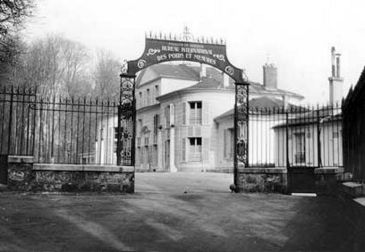International Bureau of Weights and Measures
The International Bureau of Weights and Measures (French: Bureau international des poids et mesures), is an international standards organization.[1] It is commonly referred to by its French initials of BIPM and it is one of three such organizations established to maintain the International System of Units (SI) under the terms of the Metre Convention (French: Convention du Mètre).
The other organizations that maintain the SI system are the General Conference on Weights and Measures (French: Conférence générale des poids et mesures) (CGPM) and the International Committee for Weights and Measures (French: Comité international des poids et mesures) (CIPM).
History
The BIPM was created in May 1875, following the signing of the Metre Convention by 17 nations, a treaty which had 51 signatory nations as of 2008.[2][3] The BIPM headquarters are located in Sèvres, France, where it enjoys extraterritorial status.
In 1889, the 1st CGPM sanctioned the international prototypes for the metre and the kilogram. Together with the astronomical second as the unit of time, those three units constituted a three-dimensional system similar to the centimetre-gram-second (CGS) system, but with the base units of metre, kilogram, and second, the MKS system.
In 1921, the Metre Convention treaty was revised by the 6th CGPM to extend the scope and responsibilities of the BIPM to other fields in physics. In 1927, the 7th CGPM created the Consultative Committee for Electricity (CCE), which is now the Consultative Committee for Electricity and Magnetism (CCEM).
In 1948, the BIPM began an inquiry that ended in 1954 when the 10th CGPM adopted the ampere, the kelvin and the candela as base units, for electric current, thermodynamic temperature and luminous intensity respectively.
The 11th CGPM in 1960 approved the name International System of Units, abbreviated as SI. At the 14th CGPM in 1971, the current version of the SI was completed by adding the mole as the base unit for amount of substance, bringing the total number of base units to seven.
As of 29 March 2010, there are 54 Member States of the BIPM.[4]
Scope of the BIPM
Under the authority of the Metric Convention, the BIPM helps to ensure uniformity of SI weights and measures around the world. It does so through its own laboratory work as well as through a series of consultative committees, whose members are the national metrology laboratories of the Convention's member states.
The BIPM carries out measurement-related research, organizes international comparisons of national measurement standards, and performs calibrations for member states.
The BIPM has an important role in maintaining accurate worldwide time of day. It combines, analyzes, and averages the official atomic time standards of member nations around the world to create a single, official Coordinated Universal Time (UTC).
Headquarters organization
The Director's Office and the other departments within the BIPM headquarters organization are:[5]
- Director's Office
- Scientific Departments:
- Mass
- Time
- Frequency and Gravimetry
- Electricity
- Ionizing radiation
- Chemistry
- Finance, Administration and General Services Department
- Communication and Information
- Quality, Health and Safety
- The BIPM key comparison database (KCDB)
- International Coordination and Liaison
- Mechanical workshop
As of 2010, the BIPM has an international staff of about 70 to 80 people and an annual budget of about 10,000,000 to 13,000,000 euros.[6][7]
References
- ↑ Welcome to the BIPM website
- ↑ Brief history of the SI From the BIPM website
- ↑ International aspects of the SI From the NIST website
- ↑ Member States
- ↑ Organigram of the BIPM headquarters
- ↑ The BIPM and the Metre Convention
- ↑ BIPM Job Vacancy

